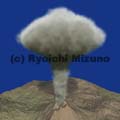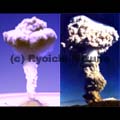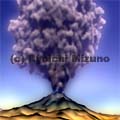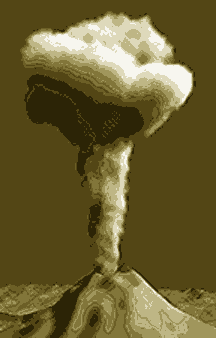Site Map:
Self Introduction:
Self Introduction with a Photograph
| Top |
 Research: Research:
Research Interests: Simple Models of Complex Phenomena for Computer Graphics.
Keywords: computer graphics, complexity sciences, computational fluid dynamics, modeling, visualization, fluids, atmospheric effects.
| Top |
Publications:
Refereed Publications:
Journal
Ryoichi Mizuno, Yoshinori Dobashi, and Tomoyuki Nishita,
Modeling of Volcanic Clouds using CML,
Journal of Information Science and Engineering (JISE), 20(2): 219-232,
2004.
.jpg) --- Abstract: --- Abstract:
In this paper, the model of volcanic clouds for computer graphics using the Coupled Map Lattice (CML) method is proposed. In this model, the Navier-Stokes equations are used, and the equations are solved by using the CML method that can be applied as an efficient fluid solver. Moreover, to generate desired shape of volcanic clouds, some parameters that allow intuitively control of the shape are provided. Hence, in this system, the behavior of the volcanic clouds can be calculated in practical calculation time, and by only changing some parameters various shapes of the volcanic clouds can be generated. Therefore, photo-realistic images/animations of various shapes of volcanic clouds can be created efficiently by the proposed approach.
| PDF |
International Conference
Ryoichi Mizuno, Yoshinori Dobashi, Bing-Yu Chen, and Tomoyuki Nishita,
Physics Motivated Modeling of Volcanic Clouds as a Two Fluids Model,
Proc. 11th Pacific Conference on Computer Graphics and Applications, 434-439,
Canmore (Canada), October 2003.
 --- Abstract: --- Abstract:
In this paper, we present a physics motivated modeling method for volcanic clouds as a two fluids model. Some previous methods model smoke or clouds as one fluid, but the volcanic clouds can not be treated as one fluid. The volcanic clouds consist of the pyroclasts, the volcanic gas and the entrained air. Since the pyroclasts and the volcanic gas can be treated as one fluid, called magma, the volcanic clouds are regarded as two fluids, the magma and the entrained air. The modeling in the 3D analysis space can be simplified to enhance the performance. Since our approach is physics motivated, it can be used to generate physically reasonable and realistic images of volcanic clouds from the volcanic initial eruption to the equilibrium situation.
| PDF |
Ryoichi Mizuno, Yoshinori Dobashi, Bing-Yu Chen, and Tomoyuki Nishita,
Modeling Volcanic Clouds: a Physical, 3D and Efficient Method,
Conference CD-ROM ACM SIGGRAPH 2003 Sketches & Applications (Simulating Nature),
San Diego (USA), July 2003.
 [ACM SIGGRAPH] [ACM SIGGRAPH]
 --- Introduction: --- Introduction:
This paper presents an efficient method based on physical laws to model volcanic clouds. Some physical models have been proposed for simulating volcanic clouds [Woods 1988], but most of the previous models are only two or less dimensional or need huge calculation times. Our approach achieves a physical, 3D and efficient modeling of volcanic clouds. The dynamics of volcanic clouds is modeled using the 2FM (2 fluids model), which can treat two kinds of fluids in a scheme. Furthermore, modeling in the 3D analysis space is efficiently implemented by appropriate and reasonable simplification of the dynamics.
| PDF |
Ryoichi Mizuno, Yoshinori Dobashi, and Tomoyuki Nishita,
Volcanic Smoke Animation using CML,
Proc. International Computer Symposium 2002 (ICS 2002), 2: 1375-1382,
Hualien (Taiwan), December 2002.
 --- Abstract: --- Abstract:
The animation of volcanic smoke is useful for natural disaster simulations, entertainments, etc. In this paper, we propose a model to generate realistic animations of the volcanic smoke. The model is designed by taking the eruption magnitude decided by the eruption velocity and the initial volcanic smoke density, the buoyancy generated by the difference between the volcanic smoke density and the atmospheric density, and the decreasing of the volcanic smoke density due to the loss of the pyroclasts (fragments of magma); i.e., this model is based on the physical dynamics of the volcanic smoke. In this model, the Navier-Stokes equations are used, and we solve the equations by using the method of the Coupled Map Lattice (CML) that is an efficient solver. Hence, in our system, the behavior of the volcanic smoke can be calculated in practical calculation time, and various shapes of the volcanic smoke can be generated by only changing some parameters. Therefore, realistic volcanic smoke animations can be created by our approach efficiently.
| PDF |
Not Refereed Publications:
Domestic Conference:
Ryoichi Mizuno, Yoshinori Dobashi, and Tomoyuki Nishita,
Simulation and Visualization of Volcanic Cloud using 2 Fluids Model,
Proc. IPSJ 65th National Convention, 4: 111-112,
Tokyo (Japan), March 2003.
 [Students' Incentive Award Paper] [Students' Incentive Award Paper]
| PDF |  [Japanese] [Japanese] Ryoichi Mizuno, Yoshinori Dobashi, and Tomoyuki Nishita,
Animation of Volcanic Smoke using CML,
Proc. IPSJ 108th CG&CAD Summer Meeting (2002-CG-108), 115-120,
Aichi (Japan), August 2002.
| PDF |  [Japanese] [Japanese] Ryoichi Mizuno, Satoru Yoshida, Yoshinori Dobashi, and Tomoyuki Nishita,
Simulation and Visualization of Volcanic Smoke using CML,
Proc. IPSJ 64th National Convention, 4: 737-738,
Saitama (Japan), March 2002.
| PDF |  [Japanese] [Japanese]
Other Publications:
Thesis:
Ryoichi Mizuno,
Modeling of Volcanic Clouds for Computer Graphics,
A Master Thesis of Dept. of Complexity Science and Engineering at The University of Tokyo,
February 2003.
 --- Abstract: --- Abstract:
The modeling of volcanic clouds is useful for natural disaster simulations, entertainments (e.g. games, movies), etc. However, in the field of computer graphics, the modeling of volcanic clouds has almost not been done so far. Then, this thesis proposes two approaches of the modeling of volcanic clouds for computer graphics. One of them uses coupled map lattice (CML) method, which is a kind of cellular automatons for generating patterns. By using the CML method, it becomes possible to simulate the behavior of the volcanic clouds efficiently. Moreover, to generate desired shaped volcanic clouds, some parameters that allow intuitively control of the volcanic clouds shape are provided. Therefore, by using the proposed method, the realistic behavior of volcanic clouds can be represented in a practical calculation time. The other approach uses the 2 fluids model (2FM). The 2FM treats two fluids in a scheme, and considers the interaction between the fluids. By using the 2FM, it becomes possible to consider the entrainment, which is essential factor of the dynamics of volcanic clouds. Moreover, the model is simplified based on a plausible assumption and an appropriate approximation. Therefore, by using the proposed method, the quantitatively reasonable three dimensional simulation of volcanic clouds behavior can be done in a practical calculation time. Moreover, this thesis presents a visualization method of volcanic clouds.
| PDF |
Ryoichi Mizuno,
Image reconstruction using parallel Monte Carlo simulations,
A Senior Thesis of Dept. of Physics at Sophia University,
February 2001.
| PDF |
| Top |
Educations:
 |
|
Ph.D. Candidate,
Department of Complexity Science and Engineering,
The University of Tokyo, 2003-. |
| |
 |
|
Master of Science,
Department of Complexity Science and Engineering,
The University of Tokyo, 2001-2003. |
| |
 |
|
Bachelor of Science in Engineering,
Department of Physics,
Sophia University, 1997-2001.
|
| |
 |
|
Seijo Gakuen Senior High School, 1994-1997.
Seijo Gakuen Junior High School, 1991-1994.
Seijo Gakuen Elementary School, 1985-1991. |
| Top |
Miscellany:
IPSJ 65th National Convention (2003): Students' Incentive Award PaperPacific Graphics 2001: StaffSIGGRAPH 2001: Japanese Representative Student Volunteer
| Top |
 Programs: Programs:
-
 OpenGL: Bézier Surface [Open-source] OpenGL: Bézier Surface [Open-source]
A Bézier Surface is a parametric tensor product surface defined by mathematical formulae, used in computer graphics, computer-aided design, and finite element modelling. It can be viewed as a generalization of a Bézier curve.
--- The alternative version written in Japanese is also available. is also available.
--- Educational Material at The University of Manchester  . .
 OpenGL: Tour Into the Picture [Open-source] OpenGL: Tour Into the Picture [Open-source]
Tour Into the Picture (TIP) is for easily making animations from one 2D picture or photograph of a scene.
--- Only the original version written in Japanese is available. is available.
 Java Applet: Mandelbrot Set [Open-source] Java Applet: Mandelbrot Set [Open-source]
The Mandelbrot Set has become popular far outside of mathematics both for its aesthetic appeal and its complicated structure, arising from a simple definition. This is largely due to the efforts of Benoit Mandelbrot (and others), who worked hard to communicate this area of mathematics to the general public.
 Java Applet: Game of Life Java Applet: Game of Life
The Game of Life is a cellular automaton devised by the British mathematician John Horton Conway in 1970. It is the best-known example of a cellular automaton.
 Java Applet: Branching: L-system Tree Java Applet: Branching: L-system Tree
An L-system or Lindenmayer system is a formal grammar (a set of rules and symbols) most famously used to model the growth processes of plant development, though able to model the morphology of a variety of organisms.
 Java Applet: Bifurcation of Logistic Map Java Applet: Bifurcation of Logistic Map
The Logistic Map is a polynomial mapping, often cited as an archetypal example of how complex, chaotic behaviour can arise from very simple non-linear dynamical equations.
--- Educational Material at The University of Tokyo  . .
 C: The Lorentz Attractor [Open-source] C: The Lorentz Attractor [Open-source]
The Lorenz Attractor, introduced by Edward Lorenz in 1963, is a non-linear three-dimensional deterministic dynamical system derived from the simplified equations of convection rolls arising in the dynamical equations of the atmosphere.
--- Only the original version written in Japanese is available. is available.
| Top |
 Links: Links:
| Top |

Feedback:
Feedback: Message Form  [HTTP over SSL] [HTTP over SSL]
| Top |
| |
|
Copyright © 2001 Ryoichi Mizuno, All Rights Reserved.
|
|
|
|




 Programs:
Programs: OpenGL: Bézier Surface [Open-source]
OpenGL: Bézier Surface [Open-source]  is also available.
is also available. .
.  OpenGL: Tour Into the Picture [Open-source]
OpenGL: Tour Into the Picture [Open-source]  is available.
is available. Java Applet: Mandelbrot Set [Open-source]
Java Applet: Mandelbrot Set [Open-source]  Java Applet: Game of Life
Java Applet: Game of Life Java Applet: Branching: L-system Tree
Java Applet: Branching: L-system Tree Java Applet: Bifurcation of Logistic Map
Java Applet: Bifurcation of Logistic Map .
.  C: The Lorentz Attractor [Open-source]
C: The Lorentz Attractor [Open-source]  is available.
is available. Links:
Links:![]()


.jpg) --- Abstract:
--- Abstract: --- Abstract:
--- Abstract: --- Introduction:
--- Introduction: --- Abstract:
--- Abstract: --- Abstract:
--- Abstract: